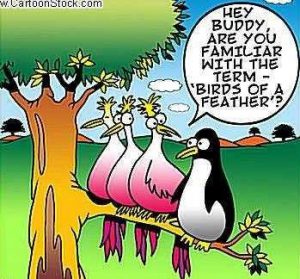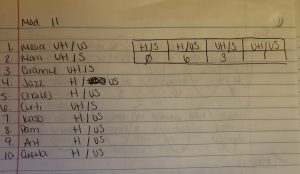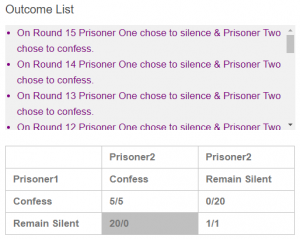Top Artifacts
Artifact 5
I learned that aggression has many dimensions. It’s much more than just physical violence and not what I originally thought. Originally, I only thought of aggression in the physical, face to face aspect. I completely neglected that it could verbally like spreading rumors or be done out of necessity such as for survival. One of the things that astonished me is that even actions deemed a part of someone’s job could be seen as an act of aggression. By definition is an action designed to hurt others. A soldier eliminating a member of the opposing army is an act of aggression because their intention is to do harm. Previously, I had never considered the role intentions may play in dictating what’s aggressive and what’s not. This filled my mind with so many questions as it changed how I viewed suicides, accidental deaths, and prey vs. predator killings. This meant that suicide and accidental deaths were not signs of aggression as ther intention was not to hurt others, although someone was indeed hurt by their actions. Lastly, I learned that aggression isn’t always bad. Aggression had always been given a bad reputation and seen as a bad trait but that isn’t always the case. In some cases it’s needed for survival, for instance, to supply food or protection.
 Aggression is often seen negatively but depending on how you look at it there may be some good in it such as to ensure survival and protection.
Aggression is often seen negatively but depending on how you look at it there may be some good in it such as to ensure survival and protection.
Artifact 4
For this artifact, I was instructed to pass out a questionnaire on attraction. One questionnaire stated that scientists have found that similarities lead to attraction and asked the subject to identify why this is true and if this statement was surprising to them. The other questionnaire claimed that opposites attract. It was surprising to see that even when people were surprised or disagreed with their statement they still managed to come up with supporting evidence as to why it was true. This shows that even when we hold a particular stance on something we can be persuaded to see things in a completely different light. Most importantly this shows how the mind works to understand things. In a few of the questionnaires respondents who disagreed with their statement noted that in certain situations the statement they were given would apply. After providing evidence for an opposing claim than one that they held, it was easier for them to agree with the claim and for their mind to find a way for both to be correct even though both claims contradict one another.

Without taking physical appearance into consideration, people with similar interests and morals seem to attract to one another.
Artifact 3
The activity for helped me to see that being unselfish can lead to happiness. I always thought that being selfish and getting everything that you would want would lead someone to be happy but that doesn’t appear to be the case. In fact, the ones I identified as selfish were unhappy and I couldn’t think of one selfish person I know who was also happy. The vast majority of happy people were unselfish and when you think about what motivates people to help others, such as empathy, this makes sense. Typically, selfish individuals aren’t very empathetic and their selfishness prevents them from helping others so they miss out on the rewards that come from doing so. They don’t feel the pleasure or receive the gratitude when a good deed is performed. But unselfishness doesn’t automatically lead to happiness. I identified one individual who’s unselfish actions have led to their unhappiness. Being unselfish isn’t enough to cause happiness but it appears to give you a greater chance of having it.

Results for this exercise show that happiness correlates with unselfishness and not selfishness like I originally thought.
Artifact 2
The prisoner’s dilemma activity showed me that cooperation involves trust, sacrifice, and unselfishness. For it to work everyone must be willing to sacrifice something for the collective whole and with some people wanting immediate gratification instead of it being delayed, confessing seems very appealing. Trusty is another important component. All it ushers is a lack of trust for either both our one party to lose out. Personal gains are a lot more important than collective gains, especially in an individualistic culture like America. Looking out for oneself is usually top priority. The game reiterated this as well. From the various playing styles included in the game they seemed to all indicate mistrust between the two prisoners and results rarely panned out good for both prisoners. During many of the rounds only moderate to no gains were afforded to either prisoner. This shows that looking out for your own self interest does little to no good for everyone, including yourself. It’s better to put the interest of everyone above your own because more than likely you’ll experience more gains this way than losses.

Looking at the chart you can see that it’s 3 out of 4 times more likely for either one or both parties to take a loss by choosing to put their own self interest first.
Artifact 1
This artifact activity showed me how uncomfortable it is to be uncomfortable and how important it is to feel good about oneself. I noticed right away when I compared the attitudes and behavior surveys that the choices that contradicted each other made me uneasy and uncomfortable because it showed that I was a hypocrite, something I don’t want to be viewed as. Before I knew it, and without actively trying, excuses poured in my head about why I had done the college opposite of the attitude I held. All of which were sufficient enough to make me feel better and show that I’m not a hypocrite. For the ones I couldn’t come up with a valid excuse I began to change the attitude rate I had initially written down, thinking I had been too generous in the beginning with my rate. This is why this exercise is my favorite. I love anything that challenges me and pushes me to do better and that’s exactly what this exercise did. One of the topics that I contradicted myself on was recycling. Although I stated it’s important I stopped doing it a few years ago but this exercise made me start again. I was previously unaware of how important it is for us to feel good about ourselves or at least content. Anything that makes us uneasy or mind quickly works to put it back at ease and in my case was to make excuses when I could and change my behavior when I couldn’t.

The infamous quote “do as I say, not as I do” is a prime example of how our actions don’t always align with the views we hold.
